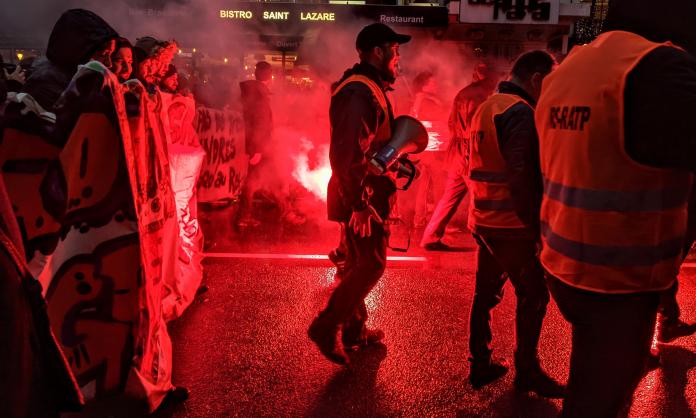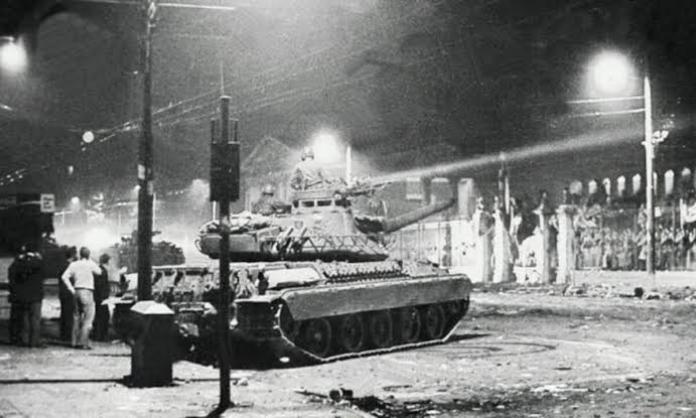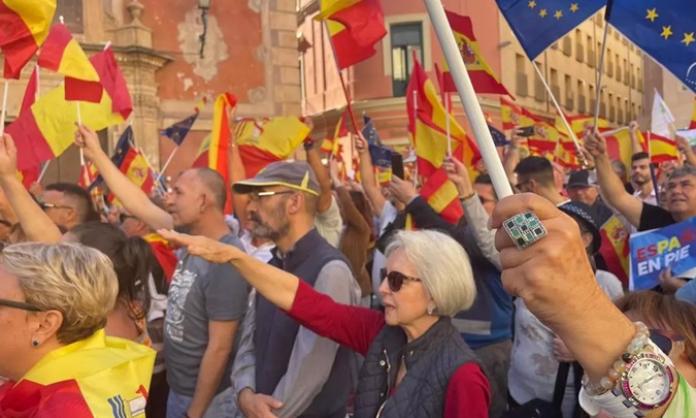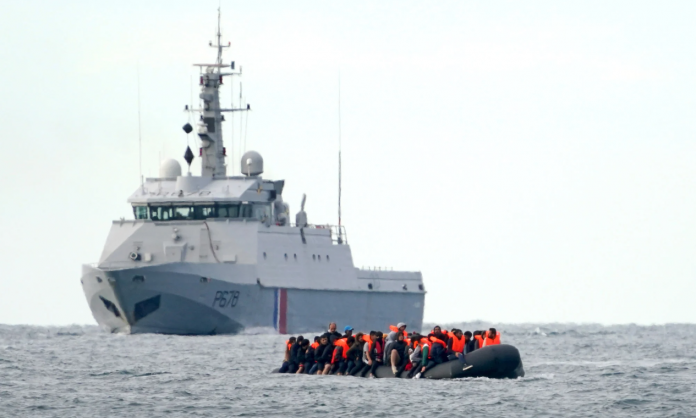Axel Persson is a train driver and secretary of the railworkers' branch of the Confédération Générale du Travail (CGT) union federation in Trappes. He was interviewed for Red Flag by Darren Roso.
Can you explain the differences and similarities of this strike wave as compared to the December 1995 strikes?
Both strikes were organised as a reaction against the government’s plan to smash the pension schemes. The difference between 1995 and 2019 is that the 1995 pension reform specifically targeted public sector workers, while the 2019 reform attacks all workers, both from the public and private sector. The situation in 2019 is much different from 1995 in the sense that organised labour (particularly the CGT union federation), while still able to wield considerable industrial muscles, has been considerably weakened in the private industrial sector as a result of decades of layoffs, redundancies, the multiplication of subcontracting, agency work, etc.
Tell us about the workers’ movement: who are in the vanguard of this struggle? Why are they at the forefront, and how are they organising?
Transport workers from the Parisian urban network are in the vanguard of the struggle. Railway workers in particular (alongside mineworkers, dockworkers, energy workers etc.) have historically been the most organised and militant section of the working class, heavily influenced by a strong militant tradition that has long been one of the strongholds of the communist movement in France.
This is reflected in working conditions. For a long time, their conditions served as a benchmark for the rest of organised labour. For example, the right to paid holidays, and the right to retire with a pension, were already won in the late 19th century or early 20th century by these workers.
The right to union representation and the first forms of collective agreements were first implemented in the railway. Organised labour, most notably within the metal industry, then took these rights as an example and organised struggles for their expansion into the other branches.
Also, given the important role of transportation in society, workers within these branches have a particular clear consciousness of the collective strength the withdrawal of their labour represents. They organise in general daily assemblies where they decide whether and how to to pursue the strike. They can also elect, depending on the specifics of their workplace, strike committees encompassing union members and non-union members, to lead and organise the strike within their specific plant, depot, station and so forth.
All decisions (including the decision to continue the strike) are taken by vote in these assemblies open to all strikers, regardless of union affiliation or not. While transport workers are at the forefront of the strike and have been so for 45 days, it is important to underline that other industries are now joining in the strike, relieving the transport workers who have gone for more than 45 days without pay. The strike was massively followed in the transport industry up until mid-January. Dockworkers started striking massively all across the country from mid-January.
What is the political significance of the strikes in France, especially after the defeat of Corbyn in Britain? How are the different political parties responding?
The political significance of the strike is tremendous in the sense that it underlines the strength the working class can act and has the potential to defeat the government.
It has also showed that it can force the government to retreat – even though the retreat has been partial. For example, the government planned to implement the reform on workers born from 1963 and onwards. The government then announced workers born before 1975 would be spared. Then the government started telling the workers who were most involved in the strikes (including railway workers and Parisian metro drivers) that only those born after 1985 would see the reform implemented, and that those who would see the reform implemented would get some kind of compensation. Many other categories (opera dancers, seafarers, air traffic controllers) got special guarantees.
The government then announced a “temporary” (implying it would be reintroduced at a later date) withdrawal from the planned bill to increase the retirement age. However, railway workers and urban transit workers in Paris refused to yield and go back to work. They vowed to pursue the fight for the entire working class and not only specific generations within specific industries. But in order to achieve that, the strike must expand and generalise across all branches and sectors.
The different political parties are responding quite differently. The traditional right wing is opportunistically saying the government has “caved in too much” to the strikers, and touts that it would implement an even harsher reform than Macron. The far right – very opportunistically so with the presidential 2022 election in mind – is paying lip service to the strikers given the unpopularity of Macron and his pension reform. The far right pretty much says what anyone wants to hear. Their different spokespersons have defined roles : some are tasked with insulting the strikers and describing them as “radicalized Muslims” with no respect for Christian traditions who even refused the “Christmas truce” called for by the government in December to halt the strike. Others call for the defence of “small businesses heavily affected by the strike”. Others support the strike all the while insisting that they “despise the trade unions and in particular the CGT”.
The left supports the strikes but has failed to effectively intervene politically beyond statements.
The far left has a certain influence amongst the strikers, particularly so in the Parisian region, with many of them playing leading roles in the strike and organizing the strikers in structures encompassing non-union and union members, developing a policy that is independent (not necessarily hostile per se) from the national union leadership.
What is the relationship between rank and file unionism, and the trade union officials from the different unions? Can you explain to an Australian audience why different unions exist in France, and what their political roles are?
Union density in France is low. An average of 11% of workers in France are unionized. Within the railway, approximately 20% are unionized. However, labor law and tradition is significantly different from many other western countries. The entire workforce takes part, for example, in general elections within the workplaces and to elect the union representatives.
Non-union members can benefit from union assistance, from the union agreements, even benefit from strike pay from the strike funds and of course, go on strike. Joining a union in France is thus often a militant act – it means you want to financially and politically support the union.
You will not get preferential treatment compared to a non-union member. You join the union because you want either to become active in it as an activist or because you want to support it financially or politically. So it is important to note that while unions have a decisive role in organizing the struggle, the success resides in their ability to organise ... non-union members! Which is the big paradox of the French labour movement.
The rank and file thus organises in general assemblies and expect the trade union officials to be held to account in front of all workers and not just the union members.
Historically speaking, the CGT union is the “mother” of the trade union movement in France. Founded in 1895 as a merger of the pre-existing federations into a unique and united federation, it has been widely influenced by anarcho-syndicalism in its beginnings, and then by the communist movement that organised around the Third International.
In response to that, the bourgeoisie has since fought to set up yellow trade unions or organise splits within the CGT and has of course over time then spent a lot of effort in “integrating” the CGT in “social dialogue”. In 1920, the Vatican decided to establish its own union to combat the influence of Marxism within the working class: the CFDT, Confédération française des travailleurs chrétiens, "French Confederation of Christian Workers". It later split and gave birth to the CFDT (Confédération française démocratique du travail, "French Democratic Confederation of Labour") that became non-confessional. While this CFDT union at a time (up until 1980) had a libertarian streak, its leadership organised massive purges to transform it into a yellow trade union bent on supporting the liberal agenda on the political grounds that “there is no alternative to capitalism” and workers have no choice but to try to limit the damage through social dialogue
In the current strike, it has been supporting the governments plan to implement the reform. At every concession made by the government to the strikers, the CFDT, whose national leadership has never called for any strike, has continuously called for the workers to go back to work...but to no avail.
FO (Force Ouvrière, “Workers’ Force”) was initially set up by the CIA in 1947 during the Marshall plan as a split from the CGT. The promoters of the Marshall plan insisted on the eviction of communist ministers from the post-World War II governments, and the creation of splits within the CGT. FO thus has many similarities in its structures with the CGT, albeit historically impregnated with a strong anti-communist tradition. In this strike though, it stands alongside the CGT.
UNSA (Union nationale des syndicats autonomes, “national federation of autonomous unions”) is a smaller union but that is heavily represented within the RATP (urban transit workers metro in Paris). While traditionally seen as a right wing union, mainly from the public sector, it has grown in the RATP, particularly amongst the newer generations of metro drivers. The CGT, while remaining very influential within the RATP, has lost grounds for a number of reasons and disillusioned newer generations have sought refuge in this new “autonomous” federation. Most remarkably so, the UNSA branch within the RATP has very clearly smashed the national UNSA leadership and has in reality completely ignored the national UNSA leadership's directives. The strike is, in short, in the hands of the rank and file, particularly within the transport industry.
Can you explain the way the Yellow Vest movement has intersected with the strike wave?
The Yellow Vest movement has intersected with the strike, in the sense that it has encouraged the workers to resort to an all-out fight against the government. Also, the defiance against the national union leaderships expressed by many Yellow Vests has been seen also amongst strikers, who are very determined to lead the strike and not let anybody decide for them when to stop or on what actions to take. While the Yellow Vest movement was not a strike movement per se, and that is its biggest weakness, the general atmosphere of resistance it has created, has bolstered the strikers as a whole.
Also on Red Flag: France's general strike: 21st century class struggle










